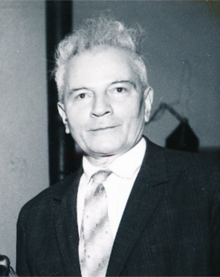| Grigor Vahramian Gasparbeg | |
|---|---|
 | |
| Born | 1900 Old Nakhchivan |
| Died | 1963 Tabriz, Iran |
| Nationality | Iranian |
| Alma mater | Moscow School of Painting, Sculpture and Architecture |
Grigor Vahramian Gasparbeg (Armenian: Գրիգոր Վահրամյան Գասպարբեգ; Russian: Григор Вахрамян Гаспарбек) was an Iranian painter of Armenian descent. Most of Gasparbeg's paintings are in oil and of classical style.
Early life
Gasparbeg was born in 1900 to Stepan and Mariam Gasparbeg in Old Nakhichevan. His parents sent him to the Tbilisi Art School where he studied under Oskar Schmerling (1863-1938) and Yeghishe Tadevosyan (1870-1936). Gasparbeg graduated from the Tbilisi Art School with a 1st in 1923. In the same year, he left Tbilisi and went to Moscow, entering the Moscow School of Painting, Sculpture and Architecture where he studied under Dmitry Kardovsky. Gasparbeg graduated from the school in 1929.
A diploma exhibition of the works of artists who studied under Kardovsky was visited by Anatoly Vasilyevich Lunacharsky, who appreciated the artistry of Gasparbeg's work.
Career
In 1934, Gasparbeg was invited by the Stage Director of the Second Moscow Art Academic Theatre, Ivan Nikolaevich Bersenev (1889-1951) to design the sets and costumes for the play Shahnameh. The play Shahnameh was translated into Russian by playwright Mkrtycha Dzhavanyan.
In 1936, Gasparbeg exhibited his paintings in an exhibition titled "One Hundred Moscow Artists". Following the exhibition, V. Kemenev wrote a review article in the 58th volume (issue 621) of the Literary Newspaper (Literaturnaya Gazeta). Kemenev’s article was titled "The beginning of the turn". One third of the article was devoted to the works of Gasparbeg who Kemenev described as "the brightest talent".
Gasparbeg designed the cover and flyleaf of the Armenian translated version of Gustave Flaubert’s Madame Bovary. The book was translated from French to Armenian by Vahe Mickaelyan and was published in Moscow in 1937.
Gasparbeg left the Soviet Union in 1938 and settled in Tabriz, Iran. From 1938 to 1950 Gasparbeg worked at his Home Art Studio where he taught painting and sculpting techniques to various students. In 1950, exhibitions dedicated to the work of Gasparbeg and his students took place in the cities of Tehran, Abadan and Tabriz. One of Gasparbeg's students is Pepi Martin who has exhibited her works in Cyprus.
Gasparbeg began teaching at the Mirak Art School in Tabriz in 1951, and married Marousia Arakelian in 1953. The couple had four children. Gasparbeg's second son is Vartan Vahramian. Gasparbeg died at his Tabriz home on 23 October 1963.
Legacy
Gasparbeg’s paintings are held in private collections across the world. Seven of his paintings are currently held in the National Art Gallery of Armenia:

- · Mother’s portrait (1928)
- · Self-portrait (1932)
- · Still life (1936)
- · Still life- tea pot and fruit (1937)
- · Portrait of Khalatian (1940)
- · Portrait of Princess Shams Zamini (1940)
- · Still life-fruit and lemons
While living in Tabriz, Gasparbeg designed the plans for a corinthian-style balcony which was built in his place of residence and remains intact to this day.
References
- Lazarian, Janet (2003). Encyclopedia of Iranian-Armenians. Iran: Hirmand. p. 363. ISBN 964-6974-50-3.
- ^ Harutunyan, Gregory (2012). Artists: Fates, Muses. Russia. ISBN 978-9939-68-105-4.
{{cite book}}: CS1 maint: location missing publisher (link) - Helbig, Elahe (2017). Suter, Rafael (ed.). "A New "Vision": Early Works of Ahmad Aali and the Emergence of Fine Art Photography in Iran (1960s–1970s)". Asiatische Studien - Études Asiatiques. 70 (4). De Gruyter Online: 1179–1218. doi:10.1515/asia-2016-0047. ISSN 2235-5871. S2CID 21751500.
- Navasargian, Alice (1997). Iran-Armenia, Golden Bridges, Twentieth Century Iranian-Armenian Painters. Glendale, California: AAA Publishing House. pp. 54, 86. ISBN 9780969762003.
- "Ivan Bersenev". Great Soviet Encyclopedia. 1979. Retrieved 14 May 2017 – via TheFreeDictionary.com.
- Maria Gregoriou (March 2018). "Brush strokes us to Wonderland". Cyprus Mail Online. Retrieved 29 January 2019.
- Rad, Azizi (December 2017). "Iranian artist resident in Turkey: Art in Iran is more worthy / young people know the value of Iranian culture and civilization". IRNA. Retrieved 16 December 2017.
- ""A scene from Tabriz after the end of WWII"". www.tabriz-emrooz.ir/ (in Persian). Tabriz Emrooz. December 2017. Retrieved 16 December 2017.
- "Documentary MAROOSYA at 2014 Arpa Festival". Arpa International Film Festival. 11 September 2014. Retrieved 9 July 2017.
- Ter Minasyan, Anush (2002). "Return to the Roots". www.aravot.am. Aravot Newspaper. Retrieved 25 November 2017.
- LLC Helix Consulting։ «Շտեմարան - Հավաքածու - Հայաստանի ազգային պատկերասրահ»։ http://www.gallery.am/hy/database/?d_l=0&d_s=0&d_a=949&kyw=&search-it=%D5%88%D6%80%D5%B8%D5%B6%D5%A5%D5%AC www.gallery.am (անգլերեն)։ Վերցված է 2017-11-20